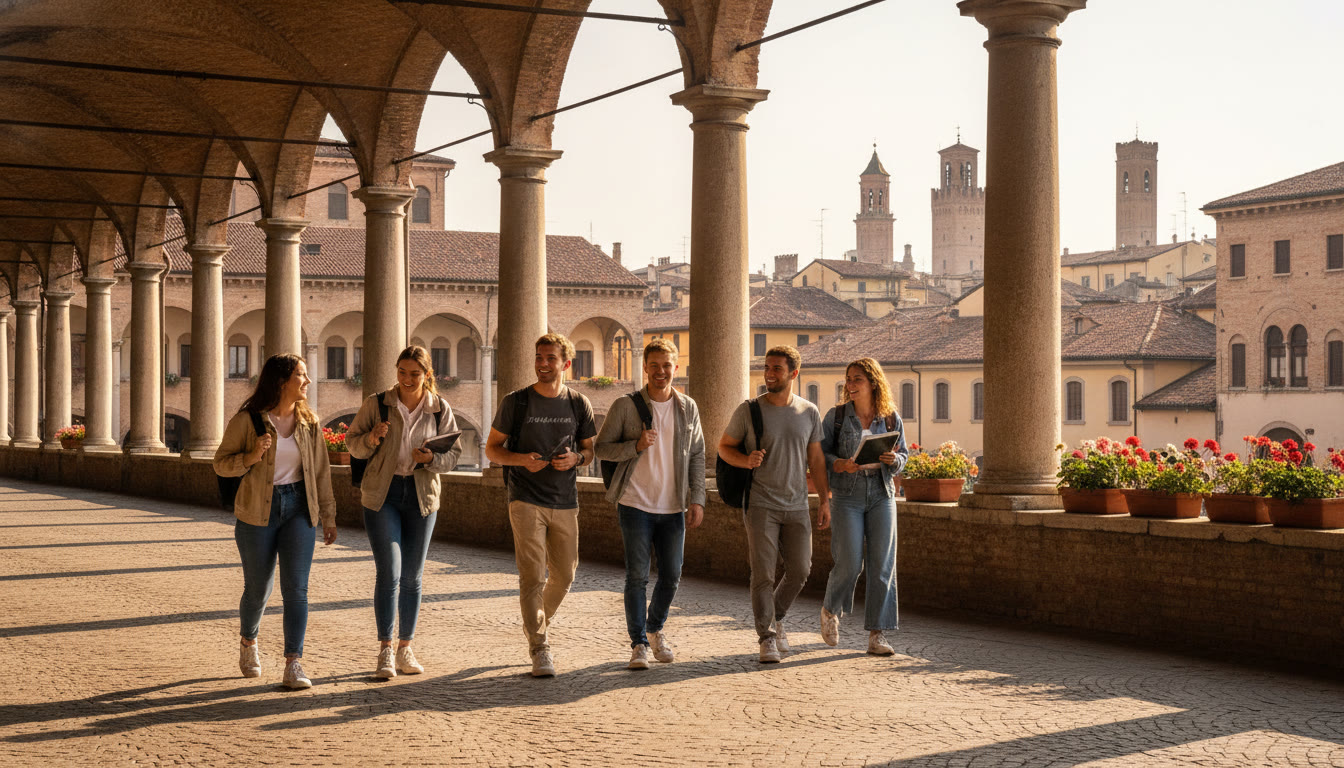Why Bologna and Politecnico di Milano matter to AP students and families
Thinking about the next big step after AP exams? Whether you’re dreaming of architecture studios framed by red-tiled roofs, engineering labs buzzing with prototypes, or simply a semester soaked in espresso and art history, Bologna and Politecnico di Milano offer two Italian flavors that excite college-bound students. This snapshot is written for students (and their families) who want an engaging, practical picture—what life looks like, how academics compare, and how AP preparation can boost your application or make your study-abroad semester richer.
A quick roadmap of what you’ll read
- Short portraits of Bologna and Politecnico di Milano
- Academic strengths and how AP courses map to programs
- Campus life, culture, and practicalities
- Application and preparation tips for AP students
- How personalized tutoring (like Sparkl’s offerings) can make a difference

Two distinct scenes: Bologna vs. Politecnico di Milano
Both Bologna and Politecnico di Milano are academic magnets, but they appeal to different sensibilities.
Bologna — the living university
Bologna is one of Europe’s oldest university cities. The University of Bologna is famous for humanities, social sciences, and law, and the city itself is a layered classroom: medieval arcades (portici), lively cafés, student-run cultural events, and a compact city center that makes walking between lectures and libraries effortless. For AP students interested in literature, history, political science, art, or interdisciplinary studies, Bologna offers an immersive cultural learning environment that complements AP-level humanities prep exceptionally well.
Politecnico di Milano — engineering and design at scale
Politecnico di Milano is Italy’s powerhouse for engineering, architecture, and design. Known for rigorous coursework, industry partnerships, and a practical, studio-based approach to learning, it attracts students who are serious about technical fields. AP Calculus, AP Physics, AP Computer Science, and AP Statistics provide a strong foundation for the demanding first-year curriculum here.
How AP courses and skills map to Italian degrees
AP classes do more than yield scores; they teach time management, analytical writing, quantitative reasoning, and laboratory habits. These skills transfer directly to both Bologna’s and Politecnico’s expectations.
Humanities and social sciences (strong fit with Bologna)
- AP English Language & Composition and AP English Literature sharpen analytical reading and essay-writing skills vital for seminars and term papers.
- AP European History and AP World History give students contextual knowledge and the ability to synthesize historical narratives—huge assets in humanities coursework.
- AP Languages (such as AP Italian Language and Culture, if available) boost language readiness and cultural fluency.
STEM and design (strong fit with Politecnico di Milano)
- AP Calculus AB/BC prepares students for foundational engineering math.
- AP Physics (1, 2, or C) aligns well with mechanics, electromagnetism, and lab-based expectations.
- AP Computer Science supports programming coursework and computational thinking.
- AP Art and Design or AP Studio Art can be a stepping stone for architecture and design portfolios.
Campus life, learning culture, and daily rhythms
University life in Italy blends rigorous academics with social rituals that expand learning beyond the lecture hall.
Classes and assessment styles
Expect a mix of lectures, seminars, studio assessments (for design and architecture), and final exams that may carry significant weight. Oral exams (viva voce) are more common in some European contexts than in typical U.S. undergraduate testing. Students who practice clear, concise argumentation in AP classes will find themselves well-prepared for these formats.
Study habits that work abroad
- Active reading: annotate primary texts and summarize in your own words.
- Studio routine: for design/architecture students, schedule daily sketch/modeling time rather than leaving projects to the last minute.
- Language immersion: keep a small notebook of idioms and useful phrases — practice them in cafés, markets, and with classmates.
Practical snapshot: costs, housing, and daily life
Living in Italy will likely be different from life at home. Below is a compact table to help you compare the typical costs and logistics in Bologna and Milan (home to Politecnico di Milano). These numbers are illustrative averages to help planning—actual costs vary by lifestyle and exchange rates.
| Category | Bologna (student average) | Milan (student average) |
|---|---|---|
| Monthly Rent (shared student flat) | Moderate | Higher |
| Food (groceries + occasional dining) | Affordable | Moderate to high |
| Local Transport | Compact, walkable — low | Extensive public transit — moderate |
| Student Life | Vibrant cultural scene, many on-foot gatherings | Fast-paced, cosmopolitan, strong industry links |
Tip: budget-conscious students often prefer shared apartments near campus. For those who prize convenience, university dorms or student residences can be worth the premium during the first term.
Application pathways and AP strategy
Applying to European universities often differs from the U.S. system. AP students looking to apply or study abroad for a semester should pay attention to application timing, required documents, and how to present AP work.
Documents and preparation
- Academic transcripts and translated grade reports—request these early from your high school.
- AP score reports can bolster your academic readiness—make sure to order official score reports if requested.
- Personal statement or motivation letter: for European programs, a concise, sincere letter explaining your interest and goals goes far.
- Portfolio (for design/architecture): curate your strongest, process-focused work. Include sketches, iterations, and final pieces with short captions describing concept and technique.
Timing and deadlines
Application deadlines may be earlier or different from U.S. cycles. Start researching deadlines at least a year ahead if you’re aiming to enroll directly after high school. Semester abroad or exchange programs typically follow the host university’s calendar—plan AP exam schedules around critical application or travel dates.
Academic and cultural advantages of choosing these cities
Both Bologna and Milan offer distinctive advantages that can shape a student’s personal and intellectual growth.
Why Bologna is more than a picturesque backdrop
- Historical depth that enriches humanities learning.
- Small-city feel—great for quick friendships and study groups.
- Food culture that doubles as social learning—cooking and dining are deeply communal in Italy.
Why Politecnico di Milano stands out
- Strong ties with industry lead to internships and real-world projects.
- Studio culture fosters iterative practice and peer learning.
- International cohorts bring diverse technical perspectives.

How AP students can craft standout applications and experiences
AP classes aren’t just badges on a transcript; they’re evidence of discipline and intellectual curiosity. Here’s how to make that count.
Academic narrative — build a coherent story
Admissions readers and program coordinators love coherence. If your AP choices (say, AP Literature, AP European History, and AP Italian Language) all feed into a passion for cultural studies, make that narrative explicit. If you’re applying to an engineering program and took AP Calculus, AP Physics, and AP Computer Science, show how each course prepared you for a specific project or research idea.
Projects, research, and portfolio work
- Independent projects: design a mini research project or creative portfolio that connects to your intended field. Document process and results.
- AP Capstone or Extended Essays: use extended writing or research to explore themes you can later reference in motivation letters.
- Short internships or shadowing: even brief practical experience demonstrates initiative and helps make your application concrete.
Preparing practically: study tips and routines for AP success and beyond
Time management and deliberate practice are your best tools. Here’s a realistic, student-tested routine that aligns AP prep with study-abroad goals.
Weekly study blueprint
- Monday–Wednesday: Concept blocks. Deep work sessions on core AP concepts (60–90 minutes per session).
- Thursday: Active practice. Timed sections, problem sets, or practice essays.
- Friday: Review and reflection. Summarize mistakes, create flashcards, and build a one-page cheat sheet.
- Weekend: Synthesis. Work on longer projects, college essays, or portfolio pieces.
Exam simulation and stress management
Simulate full-length exams under realistic conditions. Combine timed practice with recovery strategies—short physical activity, proper sleep, and social breaks help maintain stamina. Families can support by creating quiet zones and reasonable expectations during practice weeks.
How personalized tutoring can lift your preparation—where Sparkl fits
Tailored guidance can turn steady study into measurable progress. Personalized tutoring—like the 1-on-1 guidance and tailored study plans offered by Sparkl—helps students target weaknesses, refine college essays, and build discipline-specific skills (such as math problem strategies or portfolio critique). Expert tutors can also adapt AP content to fit European university expectations, making the transition smoother for study-abroad applicants.
Why some students find personalized tutoring worth the investment:
- Individualized pacing that matches a student’s strengths and limitations.
- Targeted feedback on essays and portfolios that admissions readers appreciate.
- AI-driven insights to identify learning gaps and recommend focused practice—useful when balancing AP prep with application logistics.
Day-in-the-life snapshots: a humanities student in Bologna vs. an engineering student in Milan
These short vignettes illustrate differences in daily rhythm and learning focus.
Morning in Bologna
You grab an espresso, head to a lecture on Renaissance literature, and spend the afternoon in a seminar discussing primary texts. Evening: a student-run film screening and lively debate at a local café.
Afternoon in Milan
You’re in a studio crit at Politecnico di Milano—pin-ups and constructive feedback under fluorescent lights—followed by lab work on a robotics prototype and a group meeting with an industry partner.
Checklist for AP students planning to study or apply in Italy
- Finalize AP exam calendar around planned travel and application dates.
- Collect and translate transcripts early.
- Develop a concise motivation letter that connects AP studies to your intended major.
- Build or refine a portfolio for architecture/design applicants—document process, not just polished outcomes.
- Explore language preparation—basic Italian will deepen your experience.
- Consider personalized tutoring to strengthen weak areas and prepare application materials.
Closing thoughts: marrying AP rigor with Italian opportunity
AP classes build remarkable habits: disciplined study, analytical writing, and quantitative reasoning. When you combine that foundation with the cultural depth of Bologna or the technical intensity of Politecnico di Milano, you get a learning experience that’s both rigorous and human. Families planning this path should view AP preparation not merely as test prep but as skill-building that translates into vibrant, real-world study abroad and strong applications.
Finally, remember that every student’s path is unique. Use your AP strengths to tell a coherent story, document your work thoughtfully, and don’t hesitate to seek tailored support where you need it—whether for math readiness, portfolio coaching, or personal statements. A thoughtful plan and steady habits will turn your Italian study dreams into a meaningful chapter of your academic story.
Buon viaggio—and buon studio.

















No Comments
Leave a comment Cancel